NOTE: Results from this Sea Grant-funded research are related to a project funded under a 2009 suite of Long Island Sound investigations. An initial announcement of this and other studies from this group can be found in the Spring 2009 news item, "
Sound Science for Long Island Sound."

Western Long Island Sound- Execution Rocks Light. A main station in this field study. All photos taken by Barbara A. Branca, NYSG.
Stony Brook, NY, April 14, 2014 - An estuary is a popular place. Its fairly calm water and high productivity not only make it a beautiful scene for a picnic by its edge, but also give kayakers, boaters and fishermen a perfect place to spend a sunny day. This semi-enclosed body of water is fed freshwater from rivers and saltwater from the ocean, making it a highly variable environment perfect for marine life and shorebirds to find food and reproduce.
Perfect, but only in its natural and balanced state. As people began to flock to the water’s edge to settle, estuaries began to suffer. Hypoxia, a condition of low oxygen in the bottom waters of an estuary, is well known in the Long Island Sound, especially in the more urbanized western region. Blooms of phytoplankton began to flourish as excess nutrients, like dissolved inorganic nitrogen (DIN), were discharged into the estuary from wastewater treatment plants. When phytoplankton die and settle to the estuary floor, they decay; this process involves respiration which takes oxygen from the water. Hence when there is an excess of nutrients like DIN, fueling blooms and generating too much decaying organic carbon, oxygen starts to become a scarcity in the environment. It seems that an easy fix would be to decrease DIN so that phytoplankton biomass would decline, and hypoxia would no longer be an issue- right?
Over the last couple decades, wastewater treatment plants began reducing nitrogen loads to the Sound using primary, secondary and sometimes tertiary treatments in hopes that hypoxic events would decline. However, their success in nitrogen reductions has yet to bear fruit since the Sound still suffers from severe hypoxia. This is an indication that other factors are at play, an issue that Sea Grant scholar
Elizabeth Suter pursued with co-investigators,
Kamazima M. Lwiza and
Gordon T. Taylor, both affiliated with the School of Marine and Atmospheric Sciences at Stony Brook University. Their research was recently published in the
Marine Ecology Progress Series Journal, Vol. 497: 51-67, February 5th 2014. In her undergraduate career, Ms. Suter became familiar with the sewage pollution of urban estuaries when she worked in the Lamont Doherty Earth Observatory Lab on the Hudson River Project at Columbia University. With her experience at the lab, and her environmental science degree from Hunter College, Suter was well-prepared and enthusiastic to work with Professor Taylor, her advisor, on the Long Island Sound hypoxia project.
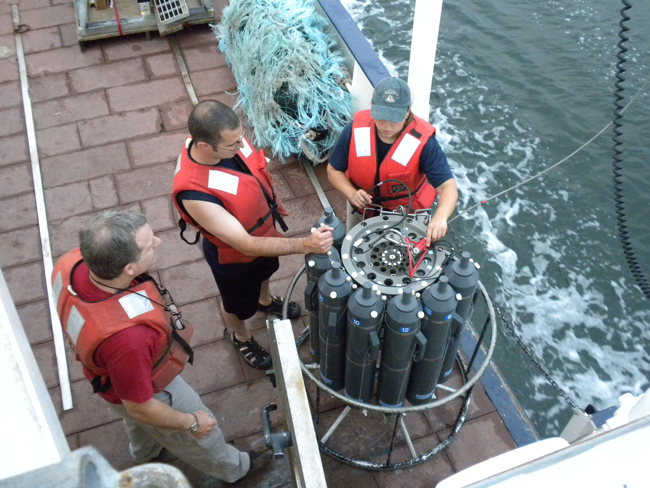
This instrument is called a rosette. It has a CTD mounted in the center to measure salinity, temperature, pressure, and dissolved oxygen. The grey bottles around it are called Niskin bottles. These are use to collect water samples. The rosette is lowered off the side of the boat from a winch and at different depths, it collects the water that we then process on deck. NYSG-funded researcher Gordon Taylor is pictured at far left.
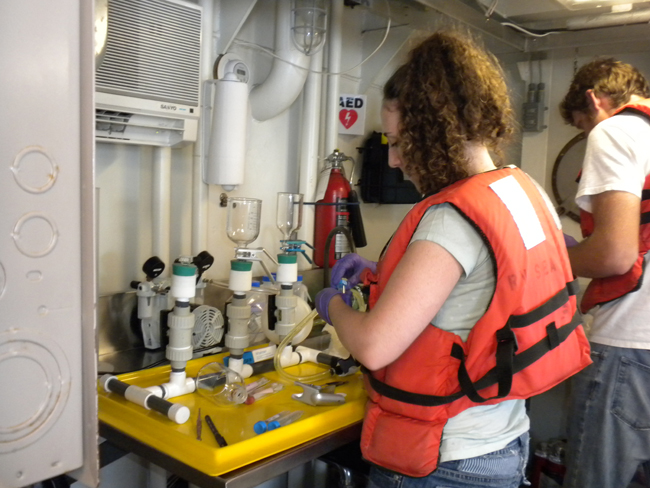
Sea Grant scholar Elizabeth Suter sets up a filtration manifold. It collects samples to measure chlorophyll a. The student next to Suter is Jake Kalda, a former undergraduate in their lab that was collecting samples to measure nutrient concentrations.
In order to recognize the impact of DIN reductions on water quality, and to explain why hypoxia still occurs, the research team analyzed both biological and physical factors within the Sound. They studied changes in nutrient concentrations and nutrient ratios that affect phytoplankton abundances and communities. They looked at physical factors such as wind characteristics that control the mixing of the water column and essentially the oxygen concentrations in the bottom waters, as well as water temperature and salinity in relation to phytoplankton biomass and dissolved oxygen.
The team found that organic nitrogen and phosphorus inputs are other players in the system that feed phytoplankton, ultimately allowing hypoxia and eutrophication (nutrient enrichment) to remain despite the reductions in DIN. With this knowledge, the team unraveled a major finding; the decline in DIN and increase of organic nitrogen and phosphorus causes a shift in phytoplankton communities. This change in water chemistry becomes advantageous for smaller celled phytoflagellates rather than diatoms. Even though reductions in DIN caused diatom abundances to decrease, the phytoflagellates can contribute excess dead organic matter allowing hypoxia to endure. This shift is also potentially altering food web dynamics. Over the long term, the system’s direct responses to DIN reductions will be observed.
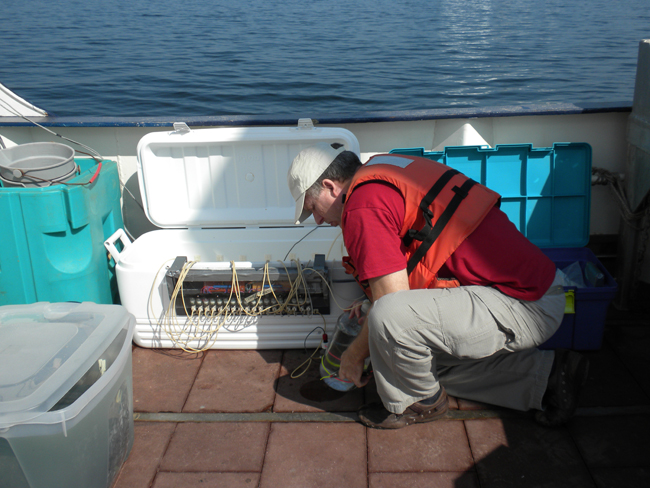
Here, Gordon Taylor is setting up the respirometer. It is an instrument that he designed and built with Tom Wilson. There are several channels with tubing connected to bags with seawater in them. The samples are incubated in the cooler at ambient temperatures. The respirometer draws sample from each bag every few minutes and draws it past an oxygen electrode. The oxygen concentration is measured and recorded electronically. In this way, the team was able to measure the drawdown of oxygen over a two or three-day period and calculate the rate of respiration for different samples.
Hypoxia alone directly affects animal communities; most shellfish and finfish will experience lethal consequences if they stay in an area that has low oxygen concentrations. Luckily, finfish can reduce harm to their populations by swimming away from oxygen-deprived areas, unlike sedentary shellfish that have no choice but to hope for the best. “The shellfish community is more vulnerable to hypoxia because they are not as mobile as finfish,” says Suter.
Suter explains how DIN has been the focus for managers as the main contributor to hypoxia, but in the last decades it is observed that organic nitrogen and phosphorus (from both sediment reservoirs and wastewater inputs) are also important to take into consideration. “Even though there are other studies that recognize the importance of organic nitrogen and phosphorus, stakeholders may not realize that.” Phytoplankton biomass continued to escalate because organic nitrogen pools and inorganic phosphorus increased simultaneously as DIN was declining. Reductions in DIN caused a decline in diatom abundances- a heavy contributor to bottom organic carbon. However, flagellated phytoplankton groups including dinoflagellates are able to thrive with lower concentrations of DIN and can more easily use the dissolved organic nitrogen pool. This causes a shift in phytoplankton communities. These phytoflagellates export organic carbon to the estuary floor as well, and contribute to the hypoxia problem.
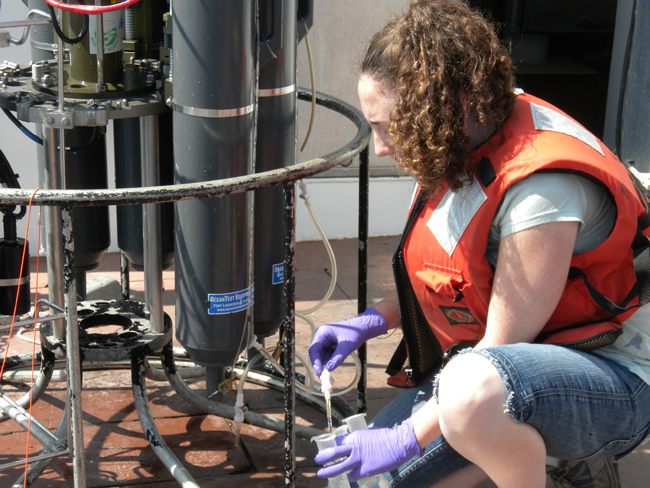
Suter rinsing syringes with seawater for measuring nutrients. Before collecting the sample, the plasticware was rinsed with the same water that was going to be sampled.
Also, food chain efficiency is hindered by the change in phytoplankton assemblages. Suter explains that energy from diatoms travels through the food chain to larger fish. This is an energy efficient pathway benefiting numerous parts of the food chain. But with the increases in smaller flagellated phytoplankton, energy efficiency declines because food chain interactions stay within the smaller end of the chain inside the microbial loop, reducing energy transfer to upper trophic levels.
Because hypoxia can cause lethal circumstances for shellfish and finfish, it is important for managers to continue investigating mitigation strategies. This study is significant because it helps prove that focusing on the reduction of DIN alone will fall short in mitigating eutrophication and hypoxia in the Long Island Sound. The shifts in phytoplankton assemblages occurred as a response to both the decline in DIN and the increase in dissolved organic nitrogen and dissolved inorganic phosphorus, causing sinking organic carbon to remain a problem. This project will not only provide scientists with a better understanding of the intricacies within the estuary, but will provide managers of the Long Island Sound Study, New York State Department of Environmental Conservation, Connecticut Department of Environmental Protection, with information to better mitigate nutrients in the Sound, benefiting anyone who wants to enjoy the estuary.
Suter mentions how adding oyster beds can help filter phytoplankton and adding certain vegetation can help to absorb nutrients. Secondary treatment used in wastewater treatment plants removes organic carbon from discharge preventing additional excess organic carbon. Tertiary treatment removes inorganic nitrogen from entering the Sound that would feed phytoplankton blooms. Both these treatments are important for wastewater treatment plants to reduce their damaging effects. Reductions in DIN should continue since impacts will be revealed over a period of time as the estuary reacts. It is important to be aware of all the complexities within the Long Island Sound in order to fully understand how to mitigate issues like hypoxia, so that the estuary has a chance to get back to its natural and balanced state.
— Barbara A. Branca
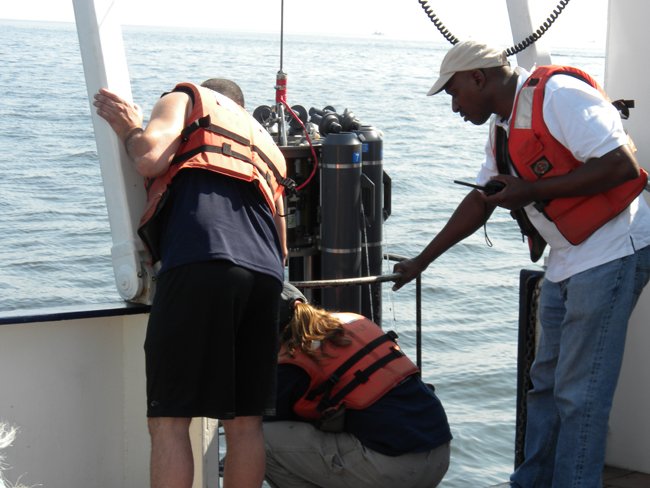
NYSG-funded researcher Kamazima M. Lwiza (at far right) leads others on this investigative team during a water sampling session using a rosette, which (as seen above and below) is being lowered into Long Island Sound.
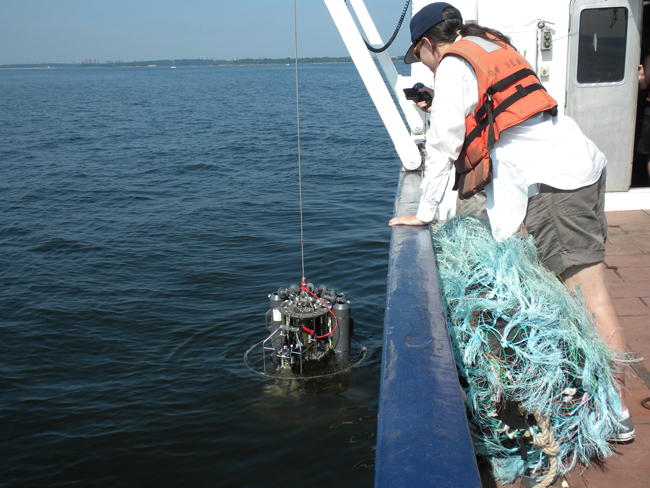
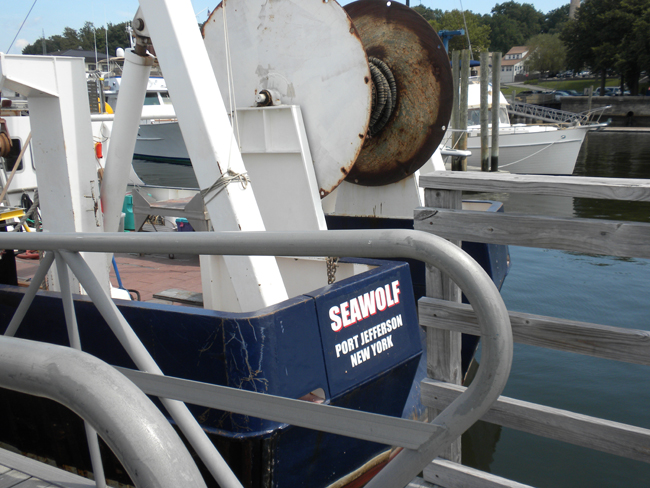
When it's not being used for investigative work, the Stony Brook University (SBU) School of Marine and Atmospheric Sciences (SoMAS)
R/V Seawolf is stationed in Port Jefferson Village, Long Island, NY.
More Info: Long Island Sound Study Research Grant Program
The Long Island Sound Study Research Grant Program is conducted by the two Sea Grant programs: New York Sea Grant, a State University of New York (SUNY) and Cornell University-based program with administrative offices at Stony Brook University on Long Island, and Connecticut Sea Grant, based at the University of Connecticut at Avery Point. Both are part of the National Sea Grant College Program network, administered by the National Oceanic and Atmospheric Administration (NOAA). Funding for the program is provided to the Sea Grant programs by U.S. Environmental Protection Agency (EPA) as part of the Long Island Sound Study, a cooperative effort between the EPA and the states of Connecticut and New York to restore and protect the Sound and its ecosystem.
More Info: New York Sea Grant
New York Sea Grant (NYSG), a cooperative program of Cornell University
and the State University of New York, is one of 33 university-based
programs under the National Sea Grant College Program (NSGCP) of the
National Oceanic and Atmospheric Administration (NOAA). The NSGCP
engages this network of the nation’s top universities in conducting
scientific research, education, training and extension projects designed
to foster science-based decisions about the use and conservation of our
aquatic resources. Through its statewide network of integrated
services, NYSG has been promoting coastal vitality, environmental
sustainability, and citizen awareness about the State’s marine and Great
Lakes resources since 1971.
For updates on Sea Grant activities:
www.nyseagrant.org has RSS,
Facebook,
Twitter, and
YouTube links. NYSG also offers a free e-list sign up via
www.nyseagrant.org/coastlines for
NY Coastlines, its flagship publication, which, in 2014, merges with the program's e-newsletter,
Currents.
NY Coastlines is published several times a year.